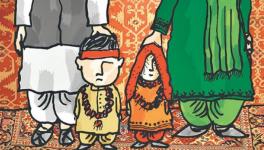India Ranks Poor in Wellbeing of Children Among Neighbours
Image for representational use only.Image Courtesy : Deccan Chronicle
New Delhi: India’s record in keeping its children healthy and happy is the poorest among all its neighbouring countries, except Pakistan. According to the End of Childhood Index, which is a part of the Global Childhood Report, India ranks 113 out of 176 countries in the wellbeing of children. The report was released on May 28, 2019, by Save the Children, a non-profit that has been working for child rights for a century.
The End of Childhood Index 2019 compared latest data from 176 countries and assessed the countries in which the most and fewest children are missing out on childhood. Singapore topped the ranking with a score of 989 out of 1,000, and at 394, Central African Republic scored the lowest. India scored 769 on this index. In 2000, India had scored 632. India’s rank also rose from 116 of 172 countries in 2018 to 113 of 176 countries.
The report evaluated countries on eight indicators to determine the wellbeing of children and teenagers (0-19 years). These eight indicators are mortality among children under five years of age, malnutrition that stunts growth, lack of education, child labour, early marriage, adolescent births, displacement by conflict, and child homicide.
According to the Global Childhood report, an estimated 970 million children had been robbed of their childhood because of these indicators. By 2019, the number fell by 29% to 690 million. The report also said that the overall situation for children has improved in 173 out of the 176 countries since 2000.
India has reduced its child mortality rate by 55% in last 19 years, from 88 deaths per 1,000 births in 2000 to 39 deaths per live births in 2017, according to the Levels & Trends in Child Mortality report by UNICEF, WHO, the United Nations Population Division and the World Bank Group.
However, among its neighbouring countries, India’s performance on under-five mortality was only better than that of Pakistan. Its other neighbours, Nepal, Bangladesh, Bhutan, China, and Sri Lanka all outperformed India. At 8.8 deaths per 1,000 live births, India has the lowest child mortality rate among these countries.
Most of the deaths among children under five in India are attributed to preventable infectious diseases, followed by injuries, meningitis, measles, and malaria.
The prevalence of stunting is also quite high in India. As of 2018, 37.4% of children under five were stunted. Here too, India ranked only above Pakistan among its neighbours. At 6%, China has the lowest stunting rate in the region. Pakistan has a stunting rate of 40.8%.
According to the Global Childhood Report, 20.2%, that is, more than 1 in 5 Indian children (aged 8-16) were out of school as of 2018. In the area, Pakistan’s performance is worst, at 40.8. All the other countries in the region outperformed India.
India has the greatest number of Child labourers in the world, Indiaspend reported in 2017. According to the End of Childhood Index, 11.8% of children are engaged in child labour. These children are deprived of education, and are exposed to unsafe and toxic environments that lead to irrecoverable health damage.
Since 2000, India had halved its number of child marriages by 2018. According to the Global Childhood Report, the decline has been fastest among girls younger than 15 years of age. The child marriage rate in India was at 15.2%, as of 2018.
Number of adolescent births in India has also fell by 63% since 2000, resulting in 2 million fewer young mothers. The progress in India alone accounts for nearly three-quarters of the global reduction in adolescent births – from 16 million to 13 million. As of 2018, the adolescent birth rate – that is births per 1,000 girls aged 15-19 years – in India was 24.5%, which is still higher that three of its neighbouring countries, Bhutan, Sri Lanka, and China.
The report recommended that a minimum financial security for all children through child-sensitive social protection should be on the agenda of governments of all countries. It added that adopting a national action plan to reduce and eliminate child poverty, together with dedicated budgets and monitoring systems that track improvements in poverty related deprivations, will help achieve better childhood outcomes.
Get the latest reports & analysis with people's perspective on Protests, movements & deep analytical videos, discussions of the current affairs in your Telegram app. Subscribe to NewsClick's Telegram channel & get Real-Time updates on stories, as they get published on our website.
























